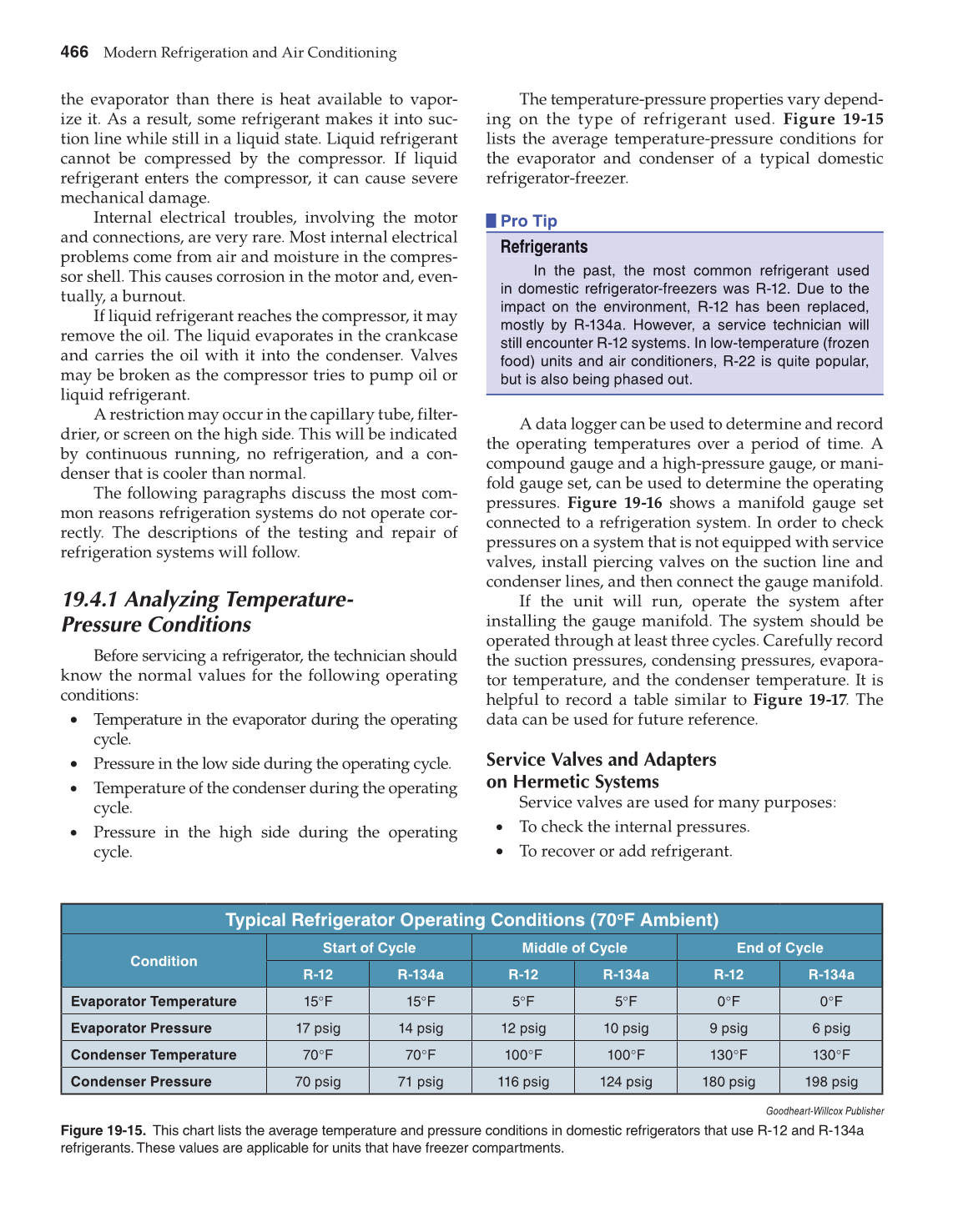466
Modern Refrigeration and Air Conditioning
the evaporator than there is heat available to vapor-
ize it. As a result, some refrigerant makes it into suc-
tion line while still in a liquid state. Liquid refrigerant
cannot be compressed by the compressor. If liquid
refrigerant enters the compressor, it can cause severe
mechanical damage.
Internal electrical troubles, involving the motor
and connections, are very rare. Most internal electrical
problems come from air and moisture in the compres-
sor shell. This causes corrosion in the motor and, even-
tually, a burnout.
If liquid refrigerant reaches the compressor, it may
remove the oil. The liquid evaporates in the crankcase
and carries the oil with it into the condenser. Valves
may be broken as the compressor tries to pump oil or
liquid refrigerant.
A restriction may occur in the capillary tube, filter-
drier, or screen on the high side. This will be indicated
by continuous running, no refrigeration, and a con-
denser that is cooler than normal.
The following paragraphs discuss the most com-
mon reasons refrigeration systems do not operate cor-
rectly. The descriptions of the testing and repair of
refrigeration systems will follow.
19.4.1 Analyzing Temperature-
Pressure Conditions
Before servicing a refrigerator, the technician should
know the normal values for the following operating
conditions:
• Temperature in the evaporator during the operating
cycle.
• Pressure in the low side during the operating cycle.
• Temperature of the condenser during the operating
cycle.
• Pressure in the high side during the operating
cycle.
The temperature-pressure properties vary depend-
ing on the type of refrigerant used. Figure 19-15
lists the average temperature-pressure conditions for
the evaporator and condenser of a typical domestic
refrigerator-freezer.
Pro Tip
Refrigerantserantsgefri
In the past, the most common refrigerant used
in domestic refrigerator-freezers was R-12. Due to the
impact on the environment, R-12 has been
mostly by R-134a. However, a service technician will
still encounter R-12 systems. In low-temperature
food) units and air conditioners, R-22 is quite
but is also being phased out..
A data logger can be used to determine and record
the operating temperatures over a period of time. A
compound gauge and a high-pressure gauge, or mani-
fold gauge set, can be used to determine the operating
pressures. Figure 19-16 shows a manifold gauge set
connected to a refrigeration system. In order to check
pressures on a system that is not equipped with service
valves, install piercing valves on the suction line and
condenser lines, and then connect the gauge manifold.
If the unit will run, operate the system after
installing the gauge manifold. The system should be
operated through at least three cycles. Carefully record
the suction pressures, condensing pressures, evapora-
tor temperature, and the condenser temperature. It is
helpful to record a table similar to Figure 19-17. The
data can be used for future reference.
Service Valves and Adapters
on Hermetic Systems
Service valves are used for many purposes:
• To check the internal pressures.
• To recover or add refrigerant.
R
In the past, the most common refrigerant used
i n domestic refrigerator-freezers was R-12. Due to the
impact on the environment, R-12 has been replaced,replaced,
m ostly by R-134a. However, a service technician will
still encounter R-12 systems. In low-temperature ((frozen frozen
food ) units and air conditioners, R-22 is q uite popular,popular,
b ut i s al so being phased out
Typical Refrigerator Operating Conditions (70oF Ambient)
Condition
Start of Cycle Middle of Cycle End of Cycle
R-12 R-134a R-12 R-134a R-12 R-134a
Evaporator Temperature 15°F 15°F 5°F 5°F 0°F 0°F
Evaporator Pressure 17 psig 14 psig 12 psig 10 psig 9 psig 6 psig
Condenser Temperature 70°F 70°F 100°F 100°F 130°F 130°F
Condenser Pressure 70 psig 71 psig 116 psig 124 psig 180 psig 198 psig
Goodheart-Willcox Publisher
Figure 19-15. This chart lists the average temperature and pressure conditions in domestic refrigerators that use R-12 and R-134a
refrigerants. These values are applicable for units that have freezer compartments.
